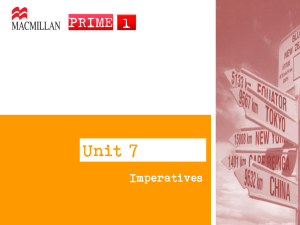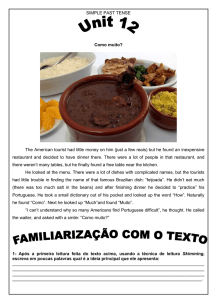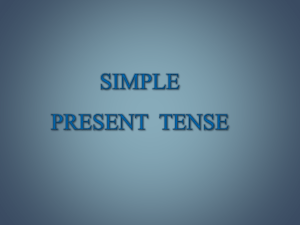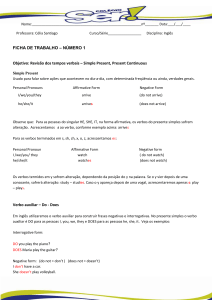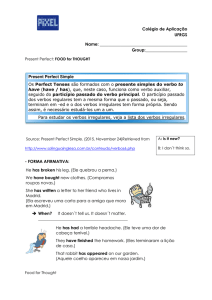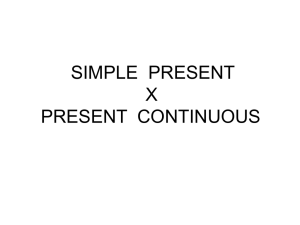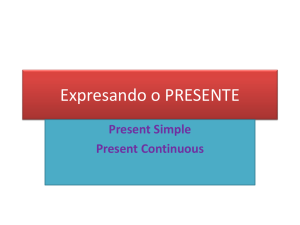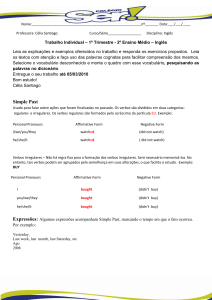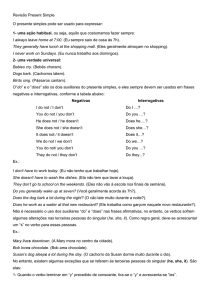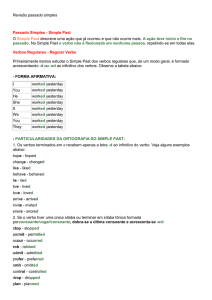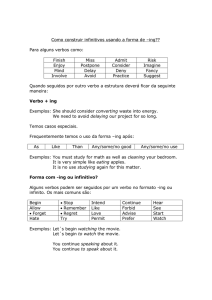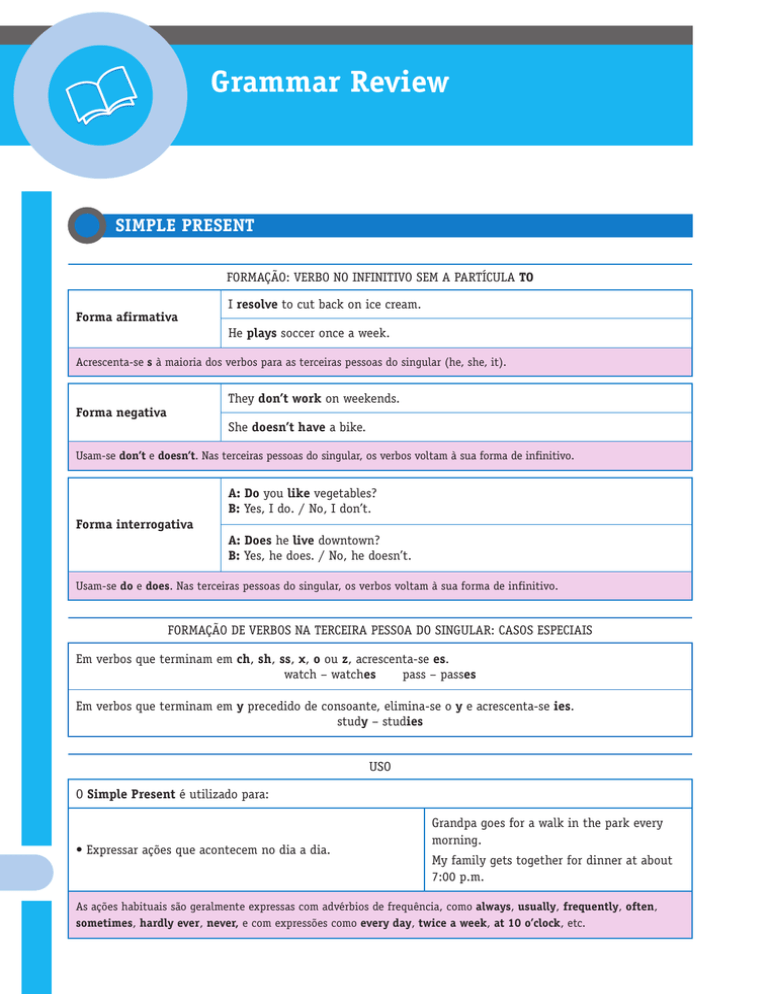
Grammar Review
SIMPLE PRESENT
FORMAÇÃO: VERBO NO INFINITIVO SEM A PARTÍCULA TO
Forma afirmativa
I resolve to cut back on ice cream.
He plays soccer once a week.
Acrescenta-se s à maioria dos verbos para as terceiras pessoas do singular (he, she, it).
They don’t work on weekends.
Forma negativa
She doesn’t have a bike.
Usam-se don’t e doesn’t. Nas terceiras pessoas do singular, os verbos voltam à sua forma de infinitivo.
A: Do you like vegetables?
B: Yes, I do. / No, I don’t.
Forma interrogativa
A: Does he live downtown?
B: Yes, he does. / No, he doesn’t.
Usam-se do e does. Nas terceiras pessoas do singular, os verbos voltam à sua forma de infinitivo.
FORMAÇÃO DE VERBOS NA TERCEIRA PESSOA DO SINGULAR: CASOS ESPECIAIS
Em verbos que terminam em ch, sh, ss, x, o ou z, acrescenta-se es.
watch – watches pass – passes
Em verbos que terminam em y precedido de consoante, elimina-se o y e acrescenta-se ies.
study – studies
USO
O Simple Present é utilizado para:
• Expressar ações que acontecem no dia a dia.
Grandpa goes for a walk in the park every
morning.
My family gets together for dinner at about
7:00 p.m.
As ações habituais são geralmente expressas com advérbios de frequência, como always, usually, frequently, often,
sometimes, hardly ever, never, e com expressões como every day, twice a week, at 10 o’clock, etc.
% Frequency Adverbs
Alessandro Passos da Costa
100
80
60
40
My classmates and I usually arrive early at
school.
We never go out in the evening.
Diana’s daughter chats online three times
a week.
20
0
always
usually
often/
frequently
sometimes
hardly
ever
never
• Fazer referência a fatos permanentes.
Uncle Peter lives in California.
• F alar sobre ações que acontecerão no futuro, com horários
ou períodos agendados no presente.
Preacher’s kids arrive from the U.S. tomorrow
morning.
• Registrar verdades universais e localizações geográficas.
Water boils at 100 degrees centigrade.
Brazil lies in South America.
PRESENT CONTINUOUS
FORMAÇÃO: VERBO TO BE NO PRESENTE + VERBO PRINCIPAL + ING
The increase in the emission of greenhouse effect gases is
forming a thick layer of these gases around the Earth.
Forma afirmativa
Acrescenta-se ing ao final da maioria dos verbos.
Forma negativa
She isn’t working today. She’s off.
Forma interrogativa
A: Are you watching the news?
B: Yes, I am. / No, I’m not.
FORMAÇÃO DO VERBO PRINCIPAL: CASOS ESPECIAIS
Nos verbos que terminam em consoante + e,
elimina-se o e e acrescenta-se ing.
Nos verbos que terminam em consoante + vogal
+ consoante e que têm a última sílaba tônica,
dobra-se a última consoante e acrescenta-se ing.
live – living
write – writing
put – putting
begin – beginning
USO
O Present Continuous é utilizado para:
• Descrever ações que acontecem no momento da
fala. Geralmente acompanham advérbios de tempo
como now, at the moment, etc.
The teacher is talking about global warming now.
Listen! They are playing the guitar.
• E xpressar ações que estão ocorrendo por um
determinado período ou nos dias atuais.
This semester the students are reading up on the
increase in the planet’s temperature.
Most people around the world are changing some of
their habits to save our planet.
• F alar sobre ações que foram agendadas, planejadas
ou confirmadas anteriormente.
My classmates and I are visiting the planetarium
on Monday.
Mr. Johnson is coming to the office at noon.
•A
lguns verbos em inglês não são utilizados com
ing, tais como love, hate, like, prefer, remember,
forget, understand, know, need, etc.
We know that we can all help reduce the threat of
global warming.
Do you understand how temperature rise occurs?
FUTURE WITH GOING TO
FORMAÇÃO: VERBO TO BE NO PRESENTE + GOING TO + VERBO PRINCIPAL
Forma afirmativa
The students are going to read about internet traffic.
Forma negativa
Melissa isn’t going to swim today. She’s tired.
Forma interrogativa
A: Are you going to write that text in Mandarin?
B: Yes, I am. / No, I’m not.
USO
O futuro com going to é utilizado para:
• F alar sobre eventos ou situações que
acontecerão no futuro com base em
evidências do presente.
• E xpressar intenções ou planos futuros e
previsões.
The present statistics show that the number of internet
users in Brazil is going to grow more and more.
Dad is going to buy a new car in December.
Those students are going to use the internet in class next
year.
• Geralmente vem acompanhado de advérbios de tempo como tomorrow, next, etc.
Imperatives
FORMAÇÃO: VERBO NO INFINITIVO SEM A PARTÍCULA TO
Forma afirmativa
Open that door, please. It’s hot in here.
Forma negativa
Don’t call Jimmy now. He’s studying.
USO
O imperative é utilizado para:
• Expressar uma ordem.
Help your mom in the kitchen, Audrey. She’s late with lunch.
• Fazer pedidos.
Ask David to download the video about e-commerce spending.
• Dar instruções.
Press the button before you use the equipment.
PERSONAL PRONOUNS
Subject
Object
I
you
he
she
it
we
you
they
me
you
him
her
it
us
you
them
USO
Os subject pronouns são usados como sujeito em uma
oração. Os object pronouns são usados como objeto
direto ou indireto.
She likes Aunt Sophie. Aunt Sophie likes her too.
SIMPLE PAST
Forma afirmativa
Tarsila do Amaral initiated her Pau-Brasil phase.
Forma negativa
Mike didn’t go to work by car this morning.
Usa-se didn’t e o verbo volta à sua forma de infinitivo.
Forma interrogativa
Usa-se did e o verbo volta à sua forma de infinitivo.
A: Did the students organize the art exhibition?
B: Yes, they did. / No, they didn’t.
FORMAÇÃO DE VERBOS REGULARES
Regra geral: verbo no infinitivo sem a partícula
to + ed.
work – worked
Casos especiais:
• Em verbos que terminam em e, acrescenta-se d.
like – liked
decide – decided
• Em verbos que terminam em y precedido de
consoante, elimina-se o y e acrescenta-se ied.
study – studied
marry – married
• E m verbos que terminam em consoante + vogal +
consoante, cuja sílaba tônica é a última, dobra-se a
última consoante e acrescenta-se ed.
stop – stopped
permit – permitted
FORMAÇÃO DE VERBOS IRREGULARES
be – was, were
buy – bought
come – came
cut – cut
Não há uma regra geral. Recomenda-se a
aprendizagem pelo uso constante dos verbos.
As formas negativa e interrogativa do verbo to be não
necessitam do uso do auxiliar did.
The students weren’t tired after the sports
competition.
Were you at the club at this time yesterday?
USO
O Simple Past é utilizado para:
• Expressar ações que terminaram em um tempo
Tarsila do Amaral returned to São Paulo in 1922.
determinado. Neste caso, advérbios de tempo e
My parents bought a very expensive painting last
expressões adverbiais (yesterday, last week, in 2008,
week.
three days ago, etc.) são geralmente utilizados.
• Indicar hábitos no passado.
I went to my grandparents’ house on Sundays when
I was little.
PAST CONTINUOUS
FORMAÇÃO: VERBO TO BE NO PASSADO + VERBO PRINCIPAL + ING
Forma afirmativa
I was reading an article about urban tribes ten minutes ago.
Forma negativa
It wasn’t raining at 10 a.m. The day was wonderful.
Forma interrogativa
A: Were the kids playing in the yard before lunch?
B: Yes, they were. / No, they weren’t.
USO
O Past Continuous é utilizado para:
• E xpressar ações em progresso em um
determinado período no passado.
•D
escrever uma ação que estava ocorrendo
quando outra aconteceu.
• I ndicar duas ou mais ações que ocorreram
ao mesmo tempo no passado.
My neighbors were cleaning the house at 9:00.
I was working on my project at this time yesterday.
When I saw Jane and her sister, they were talking to a
cumbiero.
My friends and I were jogging when it started to rain.
My brother was chatting while I was sleeping.
While Aunt Betsy and Uncle Joseph were cooking, we were
setting the table.
POSSESSIVE ADJECTIVES AND PRONOUNS
Possessive adjectives
Possessive pronouns
my
mine
your
yours
his
his
her
hers
its
its
our
ours
your
yours
their
theirs
USO
Os possessive adjectives são posicionados antes
de substantivos.
This is my computer.
Look! Swellen is wearing her black skirt again.
Os possessive pronouns substituem os
substantivos aos quais se referem.
I’m eating my sandwich now.
Are you eating yours (your sandwich)?
Os possessive pronouns podem ser usados em
expressões como: a friend of..., a relative of...,
an enemy of..., etc.
A friend of mine is coming for holidays.
MODAL VERBS
Os verbos modais (can, could, must, may, might e should) são verbos auxiliares que dão um
significado específico para o verbo principal.
Esses verbos:
• são utilizados no infinitivo sem to;
• precedem o verbo principal;
• têm a mesma forma para todas as pessoas;
• não necessitam de outros verbos auxiliares para as formas negativas e interrogativas.
USO
Can, Could (pode, podia, poderia)
São utilizados para:
• Expressar capacidade e habilidade.
Stem cell therapy can repair a damaged tissue.
Geoffrey could read when he was four.
Formas negativas: can’t / couldn’t
• Expressar capacidade ou habilidade,
can e could podem ser substituídos
por be able to.
The students can understand what stem cells are used for.
⇓
The students are able to understand what stem cells are used for.
Could Patrick swim well when he was young?
⇓
Was Patrick able to swim well when he was young?
Formas negativas:am not / aren’t / isn’t able to (present)
wasn’ / weren’t (past)
Could you please send me the article about technology and
health?
• E xpressar um pedido, solicitar ou
conceder permissão e oferecer ajuda.
A: Can I use your cell phone for a minute?
B: Yes, you can. / No, you can’t.
You can open the door now, John.
Can I help you with lunch?
Must (deve)
É utilizado para:
• Expressar obrigação e dedução.
Candidates must arrive thirty minutes before the exam.
Derek must be tired after his soccer practice. After all, he has
been playing for three hours.
Na forma negativa, must not (mustn’t)
indica proibição.
Students mustn’t use their cell phones in class.
Have to pode ser utilizado no lugar
de must para indicar obrigação, sem
alteração de sentido.
Those scientists must learn more about stem cell transplants.
⇓
Those scientists have to learn more about stem cell transplants.
Formas negativas: don’t/doesn’t have to
• E xpressar uma obrigação no passado,
usa-se had to.
Dr. Phillip had to go to his office last Saturday.
Forma negativa: didn’t have to
May, might (pode, podia, poderia)
São utilizados para:
• E xpressar possibilidade e dedução.
Para expressar possibilidade, might
é menos usado do que may, por ser
mais formal.
The body’s ability to grow may fail sometimes.
Many health problems might be treated by stem cells.
•M
ay também pode ser utilizado
para fazer um pedido, pedir ou dar
permissão e oferecer ajuda num
contexto mais formal.
May I talk to you, Mr. Bennett?
You may take the day off next Saturday, Ray.
Hello, Mrs. Smith. May I help you with the bags?
• E xpressar permissão, may pode ser
substituído por be allowed to.
You may ask questions to the chairman now.
⇓
You are allowed to ask questions to the chairman now.
Formas negativas: am not / aren’t / isn’t allowed to (present)
wasn’t / weren’t allowed to (past)
Should (deve, deveria)
• É utilizado para expressar conselho ou
recomendação.
Forma negativa: shouldn’t
You should go to work on foot twice a week.
Our students should read articles about organic foods.
COUNTABLE AND UNCOUNTABLE NOUNS
Os substantivos podem ser classificados em contáveis (countable) ou incontáveis (uncountable).
Os substantivos contáveis recebem a forma do singular ou do plural.
No apêndice da unidade 5, na página 162, vimos que há diferentes maneiras de se fazer a forma plural dos
substantivos. Se julgar necessário, consulte o apêndice novamente.
Os substantivos contáveis podem ser precedidos por:
• Artigos definidos ou indefinidos
the flower
a floating boat
the boats
an orchard
• Many (muitos, muitas)
There are many floating markets around the city.
• A few (alguns, algumas)
We should plant more flowers in our garden. There are only
a few flowers now.
• Few (poucos, poucas)
That poor girl has few toys to play with.
Os substantivos incontáveis são apenas usados no singular. Podem ser precedidos por:
• Much (muito, muita)
John doesn’t have much time to write long reports.
• A little (algum, alguma)
The child has a little money to buy a candy bar.
• Little (pouco, pouca)
There was little time for the tourists to see Hindu pilgrims
in the Ganges.
Notas
Plenty of, a lot of e lots of podem substituir
much e many, principalmente em frases
afirmativas.
The room needs plenty of (much) fresh air.
Patrick took a lot of (much) money when he traveled last
May.
Mom bought lots of (many) vegetables for the week.
Algumas expressões podem ser utilizadas
para indicar a quantidade de substantivos
incontáveis.
a cup of coffee
a slice of bread
a glass of cold tea
a bottle of water
Alguns substantivos incontáveis são usados no
plural para expressar significados específicos:
“Small wooden boats laden with fruits [...]” (frutas
diversas)
“[...] in the sacred waters of the Ganges.” (nas águas
sagradas do Ganges)
a jug of juice
a can of soda
a piece of cake
a carton of milk
COMPARISON OF ADJECTIVES
Os adjetivos podem ser utilizados em dois graus: comparative e superlative. No primeiro caso, quando se quer
comparar as características que esses adjetivos atribuem aos substantivos; no segundo caso, quando se quer
intensificá-las.
Comparative (comparando dois itens)
O grau comparativo pode ser de:
• Igualdade (tão… quanto)
These dresses are as fashionable as those ones.
• Inferioridade (menos… do que)
Bob’s sneakers are less expensive than mine.
• Superioridade (mais… do que)
Ao final de adjetivos de uma sílaba normalmente
acrescentamos er. O mesmo acontece com alguns
adjetivos de duas sílabas; outros, no entanto, são
acompanhados de more... than.
Já todos os adjetivos com três sílabas ou mais são
sempre acompanhados de more... than.
The Simpsons are richer than the Jacobs.
That street behind the park is narrower than the
one in front of the market.
My uncle’s car is more modern than my aunt’s.
My young brother’s cap is more sophisticated than
my old brother’s.
Superlative (comparando um item aos demais)
O grau superlativo pode ser de:
• Inferioridade
She is the least optimistic person in the group.
• Superioridade
Ao final de adjetivos de uma sílaba, normalmente
acrescentamos est. O mesmo acontece com alguns
adjetivos de duas sílabas; outros, no entanto, são
acompanhados de the most...
Jason is the tallest boy in my class.
That was the simplest thing the Geography teacher
said today.
We had the most delicious meals in Rome when we
were in Europe.
Notas
Em adjetivos terminados em e, acrescenta-se somente
r ou st.
late later than the latest
Em adjetivos terminados em consoante + vogal +
consoante, dobra-se a última consoante antes do
acréscimo de er ou est.
big bigger than the biggest
Em adjetivos terminados em y, elimina-se o y e
acrescenta-se ier ou iest.
happy happier than the happiest
Comparações irregulares:
good – better than – the best
bad – worse than – the worst
far – farther/further than – the farthest/the furthest
SIMPLE FUTURE
FORMAÇÃO: WILL + VERBO NO INFINITIVO SEM A PARTÍCULA TO
Forma afirmativa
In coming years, biopiracy will cause traditional
populations to lose control over their resources.
Forma negativa
Flora and fauna won’t (will + not) disappear from Brazil
in the next few years.
Forma interrogativa
A: Will the Amazon rainforest recover from
deforestation?
B: Yes, it will. / No, it won’t.
USO
O Simple Future é utilizado para:
• Expressar ação ou previsão quanto ao futuro.
We will never forget about our teacher Ms. Miller.
• Fazer um pedido.
Will you please bring me your umbrella?
Geralmente vem acompanhado de advérbios ou expressões como tomorrow, next..., in..., on..., etc.
FUTURE CONTINUOUS
FORMAÇÃO: WILL BE + VERBO + ING
Forma afirmativa
Class 101 will be going on a field trip at 7 o’clock tomorrow.
Forma negativa
The Gordons won’t be traveling abroad on their next vacation.
Forma interrogativa
Will you be working tomorrow morning?
USO
O Future Continuous é utilizado para:
• E xpressar uma ação que estará ocorrendo
em um determinado tempo no futuro.
Third-world communities are sure they will be paying a high
price for biopiracy in the future.
PRESENT PERFECT
FORMAÇÃO: HAVE/HAS + PARTICÍPIO PASSADO DO VERBO PRINCIPAL
Forma afirmativa
Several companies have responded to the CBVE survey.
Your company has taken part in a volunteering project.
Unfortunately, volunteering hasn’t become a habit in Brazil.
Forma negativa
Forma interrogativa
Formas abreviadas
Many industries haven’t motivated their employees to work on
behalf of others.
A: Have you helped any charitable organizations?
B: Yes, I have./No, I haven’t.
A: Has she gained experience through volunteering?
B: Yes, she has./No, she hasn’t.
‘ve = have ‘s = has haven’t = have not hasn’t = has not
USO
O Present Perfect é utilizado para
indicar ações que aconteceram em um
passado indefinido. Essas ações podem ter
terminado ou ainda estar ocorrendo.
I have studied English here for ten years.
Pode ser usado com:
• Since (desde)
I have known him since 1990.
• For (por)
They haven’t been married for so long.
• Just (recentemente)
I can smell her perfume in the air. She has just left.
• Ever (alguma vez, já)
Have you ever traveled abroad?
• Never (nunca)
They have never tried Japanese food.
• Already (já)
Summer has already begun.
• Yet (ainda, já)
I left my CV at the store but they haven’t called me for an
interview yet.
Has your mom heard the good news yet?
• L ately, recently (ultimamente,
recentemente)
We haven’t seen her in the neighborhood recently. Has she
moved away?
• Many times (muitas vezes)
Has the little boy visited his grandma many times this month?
PRESENT PERFECT x SIMPLE PAST
O Simple Past refere-se a ações totalmente
concluídas no tempo passado.
What Mandela said about courage in 1994 is still
true.
Já o Present Perfect refere-se a ações iniciadas
no passado que ainda podem estar em
andamento no presente, ou que ocorreram no
passado, mas não podemos precisar quando.
Chico Mendes has taught the world how
important it is to preserve the Amazon.
PRESENT PERFECT CONTINUOUS
FORMAÇÃO: HAVE/HAS BEEN + VERBO PRINCIPAL + ING
Forma afirmativa
Barack Obama has been working as a community
activist since his youth.
Forma negativa
Barack Obama hasn’t been working as a community
activist since his youth.
Forma interrogativa
A: Has Barack Obama been working as a community
activist since his youth?
B: Yes, he has. / No, he hasn’t.
Formas abreviadas
’s = has
hasn’t = has not
haven’t = have not
USO
O Present Perfect Continuous é utilizado para
expressar uma ação iniciada no passado e que ainda
está em progresso por um período de tempo não
específico. É frequentemente usado com how long
para fazer perguntas e com for, since e lately nas
formas afirmativas.
A: How long has the politician been leading the
country?
B: He has been leading the country for 5 years.
PAST PERFECT
FORMAÇÃO: HAD + PARTICÍPIO PASSADO DO VERBO PRINCIPAL
Forma afirmativa
We had read the poem before we wrote the essay.
Forma negativa
We hadn’t read the poem before we wrote the essay.
Forma interrogativa
A: Had you read the poem before you wrote the essay?
B: Yes, we had. / No, we hadn’t.
Formas abreviadas
’d = had
hadn’t = had not
USO
O Past Perfect é utilizado para indicar a
ocorrência de uma ação no passado, antes
de outra ação também no passado.
Usamos o Simple Past para indicar a
segunda ação ocorrida no passado.
When the ambulance arrived, the poor man had already died.
⇓
⇓
(2nd action)
(1st action)
The play hadn’t started when I arrived at the theater.
⇓
⇓
st
nd
(2 action)
(1 action)
O Past Perfect geralmente vem acompanhado de palavras como when, after, before, already, yet.
PAST PERFECT CONTINUOUS
FORMAÇÃO: HAD BEEN + VERBO PRINCIPAL + ING
Forma afirmativa
The singer had been carrying his sorrow songs all the way from
Africa to Georgia.
Forma negativa
The singer hadn’t been carrying his sorrow songs all the way
from Africa to Georgia.
Forma interrogativa
A: Had the singer been carrying his sorrow songs all the way
from Africa to Georgia?
B: Yes, he had. / No, he hadn’t.
USO
O Past Perfect Continuous é utilizado
para expressar uma ação que estava
acontecendo no passado antes de uma
outra ação também no passado. Damos
ênfase à ação que ocorreu primeiro entre
ações no passado.
The children hadn’t been waiting for a long time when their
parents picked them up.
How long had the players been exercising when the match
started?
They had been exercising for 15 minutes when the match
started.
REFLEXIVE PRONOUNS
myself
yourself
ourselves
yourselves
himself
herself
itself
themselves
USO
Os reflexive pronouns são usados quando o
sujeito faz e sofre a ação do verbo; ou seja,
sujeito e objeto do verbo são a mesma pessoa.
Neste caso, o reflexive pronoun é posicionado
após o verbo e concorda com o sujeito.
The wife couldn’t control herself and ended up
arguing with her husband in public.
Quando queremos dar ênfase ao sujeito ou ao
objeto, o reflexive pronoun é posicionado logo
após o sujeito ou no fim da oração.
The students themselves talked to the
principal. (ênfase no sujeito)
The students talked to the principal
themselves. (ênfase no sujeito)
The students talked to the principal himself.
(ênfase no objeto)
Quando queremos dar a ideia de “sozinho” ou “sem Jack was sitting by himself in the corner of the
ajuda”, o reflexive pronoun é precedido de by.
café.
Notas
É possível usar o reflexive pronoun também
após a construção adjetivo + preposição.
I’m proud of myself for winning the
competition.
Alguns verbos, como wash, dress e shave, não
têm a sua forma reflexiva em inglês.
Does your father shave every day?
Entretanto, a forma reflexiva pode ser utilizada
se for necessário deixar claro quem fez a ação.
My son is seven years old so he can dress
himself now.
There are five people in my family. My mom
herself washes all the family’s clothes.
TAG QUESTIONS
FORMAÇÃO: VERBO AUXILIAR/MODAL + PRONOME
Declaração afirmativa –
tag question negativa
The meeting is on Saturday, isn’t it?
Declaração negativa –
tag question afirmativa
You just don’t understand, do you?
USO
Tag questions são pedidos de confirmação do que foi dito anteriormente em forma de perguntas.
Casos especiais
I am right, am I not/aren’t I?
Let’s go, shall we?
Don’t come back here, will you?
She may call, may she not?
There were no mistakes, were there?
Everybody has a PC, don’t they?
SOME, ANY, NO
Some four children die every minute in
developing countries from diseases caused by
unsafe water.
Some e any podem ter a função de adjetivos
(quando acompanham o substantivo) ou de
pronome (quando substituem o substantivo).
A: Do you have any money with you?
B: Yes, I have some. / No, I don’t have any.
USO
Some (algum, alguns, alguma, algumas, um
pouco de)
Em frases afirmativas ou interrogativas que
indiquem ofertas, sugestão ou convite, ou
quando se aguarda uma resposta afirmativa.
We need to buy some sodas for the party.
Would you like some coffee?
Do you mind if I put on some music here?
Any (algum, alguns, algumas, nenhum,
nenhuma)
Em frases negativas e interrogativas.
I don’t know any famous actors.
Do you have any questions?
Notas
Any também é utilizado em sentenças afirmativas.
a) Se o sentido for “qualquer”.
Alternative low-cost technologies will be a
global standard at any moment.
b) Se estiver precedido de uma condição com if
(se).
If you have any environmental concerns, don’t
discharge untreated domestic wastewater.
c) Se estiver acompanhando palavras de sentido
negativo como never, rarely, seldom, hardly
ever, without, etc.
Some countries rarely have any good sanitation
conditions.
No / None (nenhum, nenhuma)
Em negações, sem haver outra palavra negativa
na sentença.
They have no solution for the problem. We have
none either.
O uso de some, any e no é válido para o emprego de seus compostos.
somebody / someone
anybody / anyone
nobody / no one
something
anything
nothing
somewhere
anywhere
nowhere
RELATIVE PRONOUNS
Os relative pronouns unem uma oração ao seu antecedente, um substantivo. Eles introduzem as
orações que indicam a qual pessoa, objeto, animal ou ideia o locutor se refere.
Who refere-se a pessoas.
The Indians who live in Brazil speak a huge
number of languages.
Whom refere-se a pessoas.
A native Indian leader whom I look up to is
Raoni.
É utilizado quando o pronome relativo for objeto
do verbo.
Após preposições.
Raoni was the Caiapó tribe chief with whom
the famous singer Sting worked on behalf of
Xingu National Park.
Which refere-se a animais, objetos e ideias.
The Indian tribes which are effectively
uncontacted live by hunting and gathering in
the Amazon.
Whose indica relação de posse.
É seguido por um substantivo e nunca pode ser
omitido.
The Indian tribes whose values were learned
from their ancestors believe we should preserve
the Earth.
That refere-se a pessoas, objetos e/ou animais.
É utilizado após superlativos e palavras como
some, any, no, everything, much, little,
only e all.
The rainforest that we consider the biggest
reserve in the world is Xingu National Park.
Não é usado entre vírgulas.
Where é usado como pronome relativo para se
referir a lugares.
The environments where Brazil’s tribal peoples
live are tropical forests, grassland, scrub forest,
and semi-desert.
When refere-se a dia, mês, etc.
My mom still remembers when I started to walk.
What refere-se a objetos, assuntos – algo
determinado.
My brother didn’t talk about what had
happened yesterday.
CONDITIONAL SENTENCES (IF CLAUSES)
Conditional sentences são orações que expressam condições. Apresentam diferentes combinações
de tempos verbais e vêm relacionadas a orações principais.
Zero Conditional
If you heat water to 100 ºC, it boils.
Utilizado para falar sobre uma verdade
universal ou para dar uma ordem ou
instrução.
Simple Present
If you need help, call me.
Simple Imperative
Present
Simple Present
First Conditional
If she comes earlier, she will meet him.
Simple Future
Simple Present
Utilizado para expressar uma ação
possível de acontecer no futuro.
If they don’t study, they won’t have good grades.
Simple Present
Simple Future
Second Conditional
Utilizado para expressar uma ação
que não é real ou não é provável de
acontecer.
If I had money, I would lend you some.
Simple Past
would + verb
We wouldn’t be lost if we bought a map.
would + verb
Simple Past
Notas
If pode ser usado no início da frase
ou no meio das duas partes da frase.
Observe o uso ou não da vírgula.
If he pays me, I’ll iron his shirts for him.
They’ll wash the car if it doesn’t rain.
Na linguagem informal, em frases com
If she were my mother, I would forgive her.
if, was é mais utilizado do que were. Na
linguagem formal, were é mais comum que The teacher would choose me if I weren’t a bad student.
was.
Unless pode ser usado em lugar de if…
not.
If we don’t do something now, global warming will get
worse.
Unless we do something now, global warming will get
worse.
Third Conditional
If the students had taken some time off,
Utilizado para expressar uma ação que
não se concretizou no passado e sua
provável consequência.
Past Perfect
they would have been better prepared to
would have + Past Participle
start ­another school year.
Nota
If I have time, I can/may help you with the housework.
Verbos modais (can, may, might e could)
também podem ser usados nas três
frases condicionais.
If I had R$ 300,00, I might buy a new bike.
If Joseph had run fast, he could have won the
competition.
DIRECT AND INDIRECT SPEECH (I)
Para relatar o que uma pessoa disse, usamos o discurso direto ou o discurso indireto:
Direct speech: reproduz exatamente o que foi
dito pela pessoa. Aspas são usadas.
The teacher said, “We are going to have a test
tomorrow.”
Indirect speech: conta o que foi dito, usando
nossas palavras. Aspas não são usadas e o uso de
that é opcional.
The teacher said (that) we / they were going to
have a test the next day.
Para usarmos o discurso indireto, fazemos algumas modificações nas frases. Observe:
Direct Speech
Indirect Speech
He said, “I need to work late today.”
(Simple Present)
He said (that) he needed to work late that day.
(Simple Past)
He said, “I met Sue yesterday.”
(Simple Past)
He said (that) he had met Sue the day before.
(Past Perfect)
She said, “I will go shopping tomorrow.”
(will)
She said (that) she would go shopping the next
day. (would)
She said, “I am studying now.”
(Present Continuous)
She said (that) she was studying then.
(Past Continuous)
They said, “We were eating 5 minutes ago.”
(Past Continuous)
They said (that) they had been eating
5 minutes before. (Past Perfect Continuous)
They said, “We have finished our task.”
(Present Perfect)
They said (that) they had finished their task.
(Past Perfect)
She said “I have been studying English for
seven years.” (Present Perfect Continuous)
She sais she had been studying English for
seven years. (Past Perfect Continuous)
Mark said, “We had gone there before.”
(Past Perfect)
Mark said (that) they had gone there before.
(Past Perfect)
Com modal verbs, também temos algumas mudanças:
Direct Speech
Indirect Speech
I said, “I can arrange this party.”
I said (that) I could arrange that party.
He said, “I must have a computer to do my
job.”
He said (that) he had to have a computer to do
his job.
She said, “I may open the window.”
She said (that) she might open the window.
Notas
Quando o verbo da oração do direct speech está
no Simple Present, Future ou Present Perfect,
não há mudança obrigatória no tempo verbal da
oração no indirect speech.
He says, “I live in the suburbs.”
He says (that) he lives in the suburbs.
DIRECT AND INDIRECT SPEECH (II)
Podemos reportar as perguntas para
o discurso indireto de duas formas.
She said, “Does this restaurant accept credit cards?”
She asked if that restaurant accepted credit cards.
The old man said, “What time is it?”
The old man asked what time it was.
Em ambos os casos, as perguntas foram transformadas em frases afirmativas.
As perguntas iniciadas com auxiliares devem apresentar o uso de if (linguagem formal) ou whether
(linguagem informal). As perguntas iniciadas com pronomes interrogativos devem repetir seu uso.
Usamos a forma do infinitivo
do verbo para relatar ordens ou
pedidos expressos pelos verbos ask,
tell e order.
Dad said to us, “Come back home before midnight.”
Dad asked us to come back home before midnight.
Dad told us to come back home before midnight.
Dad ordered us to come back home before midnight.
Dad said to us, “Don’t arrive late again.”
Dad asked us not to arrive late again.
FUTURE PERFECT
FORMAÇÃO: WILL HAVE + PARTICÍPIO DO VERBO PRINCIPAL
Forma afirmativa
The Jorge Amado Foundation will have developed
several cultural activities by 2020.
Forma negativa
The story of Gabriela and Nacib Saad in Gabriela,
Clove, and Cinnamon won’t (will + not) have
ceased to enchant readers by the next decades.
Forma interrogativa
Will many people have read Captains of the Sands
by 10 years from now?
Yes, they will. / No, they won’t.
USO
O Future Perfect é utilizado para expressar
uma ação que terá (ou não) acontecido antes
de um determinado momento no futuro.
The students will have finished the project by the
end of the month.
Nota
O Future Continuous (will be + verbo + ing)
expressa uma ação que estará ocorrendo em I will be working next weekend.
um determinado tempo no futuro.
PASSIVE STRUCTURES
FORMAÇÃO: TO BE (NO MESMO TEMPO DO VERBO PRINCIPAL) +
PARTICÍPIO PASSADO DO VERBO PRINCIPAL
This new virus (2009 H1N1) was first detected in people in the United States in April 2009.
USO
A passive structure é utilizada:
• Para enfatizar a ocorrência de uma ação e não
quem a executou. Assim, só mencionamos o autor
da ação (agente da passiva) se for necessário ou
importante.
A new road is being built.
Mona Lisa was painted by Leonardo da Vinci.
• Em textos técnicos, científicos e reportagens.
A vaccine has been provided.
Notas
Em manchetes de jornal/cronologias, a voz passiva
geralmente vem sem o verbo to be.
This new virus first detected in April 2009.
(was first detected)
Quando transformamos uma frase da voz ativa para a voz passiva:
• O objeto da voz ativa torna-se o sujeito da voz passiva.
• O verbo to be é usado obrigatoriamente no tempo verbal principal da ativa.
• O verbo principal é usado no Past Participle.
Nota
Quando for mencionado quem fez a ação, usa-se by + o agente.
Quando há dois objetos (um direto e um indireto),
a transformação pode ocorrer de duas formas:
Ativa: He didn’t send me a note.
Passiva 1: I wasn’t sent a note (by him).
Passiva 2: A note wasn’t sent to me.
INFINITIVE AND GERUND FORMS
INFINITIVE
FORMAÇÃO: TO + VERBO
USO
George Daniel has said that his group will not allow able-bodied people to represent DPI in the
future. He also told us not to look down on the disabled.
Merle Khoza said disabled people were the best to articulate the issued facing them.
O infinitivo com to pode ser usado como
sujeito da oração:
To combat discrimination is to understand the
issues faced by disabled people.
FORMAÇÃO: VERBO SEM TO
USO
Let me warn you about the dangers of living
alone.
Honesty makes me feel good.
We were so touched by his life story that we did
nothing but join the DPI.
É usado depois dos verbos modais (can, may,
should), dos verbos make e let e depois de but
e except.
GERUND
FORMAÇÃO: VERBO + ING (= substantivo)
USO
Como sujeito ou objeto.
Spending all your money before Christmas wasn’t
a clever idea.
Irresponsible Chris didn’t stop smoking after she
found out she was sick.
Depois de preposições.
Are you interested in improving your fluency?
Depois de alguns verbos/expressões, tais como:
After listening to his sad tale, I couldn’t help
appreciate, avoid, can’t help, can’t stand,
crying.
consider, deny, enjoy, finish, keep, mind,
Do you mind passing me the salt?
suggest, etc.
Verbos de percepção (feel, hear, listen to, look
at, smell, taste, touch, see, watch) podem ser
usados no gerúndio ou no infinitivo sem to.
São usados no gerúndio quando a ação está/
estava em progresso.
São usados no infinitivo sem to quando a ação
foi observada, sentida, do início ao fim.
I saw the couple dancing. (Não vi toda a dança,
ela estava em progresso quando a vi.)
I saw the couple dance. (Vi toda a dança do casal,
do início ao fim.)

